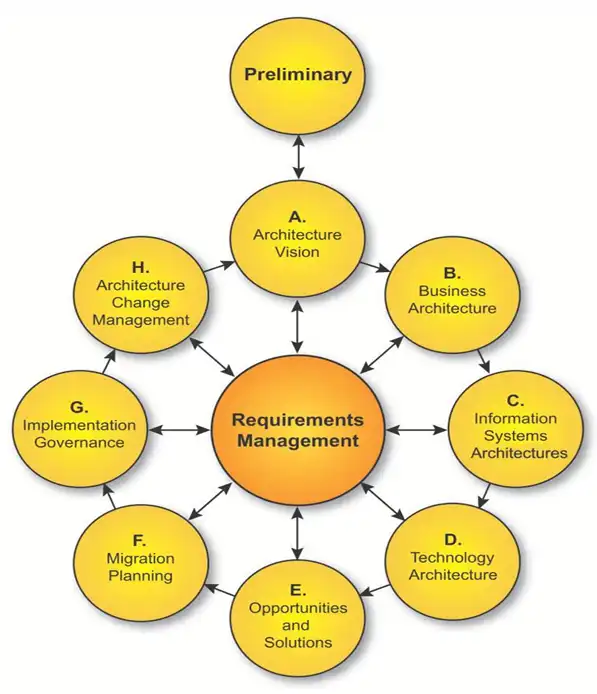ADM – Key Features
- ADM is a clear, step-by-step guide for creating Enterprise Architecture.
- It uses several repeatable phases to build the architecture.
- TOGAF provides detailed instructions, goals, steps, and results for each phase.
- The phases are repeated to allow the architecture to grow and improve gradually.
- ADM connects with different areas like frameworks, content, transitions, and governance.
TOGAF ADM framework and phases with Examples

Preliminary Phase Of TOGAF ADM framework and phases
This phase is about getting ready to start the architectural work. It includes setting up the tools, customizing the TOGAF framework, and defining key principles that will guide the architecture.
Example: A company decides to adopt TOGAF for structuring its IT projects. They begin by customizing the TOGAF framework to fit their specific needs and setting principles like “security-first” or “customer-centric.”
Phase A: Architecture Vision In TOGAF ADM framework and phases
This is the first step in developing the architecture. It focuses on defining the project’s scope, identifying stakeholders, creating a clear vision of the architecture, and getting the necessary approvals.
Example: Before starting a new software project, the team defines what the final product should achieve and who needs to be involved. They get approval to move forward based on this vision.
Phase B: Business Architecture
This phase involves creating a Business Architecture that supports the Architecture Vision. It defines how the business operates and how it will support the vision.
Example: A retail company designs its business processes to better support online shopping, aligning with its vision of becoming a leader in e-commerce.
Phase C: Information Systems Architectures
This phase focuses on developing Data and Application Architectures that support the business goals defined in the previous phases.
Example: The IT team designs a database structure and selects applications that support the company’s new e-commerce platform.
Phase D: Technology Architecture
This phase involves creating the Technology Architecture, which includes the hardware, software, and network infrastructure needed to support the project.
Example: The company decides on the cloud services, servers, and network configurations required to run its e-commerce platform.
Phase E: Opportunities and Solutions In TOGAF ADM framework and phases
In this phase, major projects are identified, and they are grouped into work packages that will help achieve the Target Architecture.
Example: The team identifies the need for a new CRM system and a website redesign, bundling them into one major project to support the e-commerce platform.
Phase F: Migration Planning
This phase is about creating a detailed plan to move from the current (Baseline) architecture to the desired (Target) architecture.
Example: The company creates a step-by-step plan for migrating its existing customer data to the new CRM system without disrupting operations.
Phase G: Implementation Governance
This phase provides oversight during the implementation to ensure the architecture is built according to the plan.
Example: As the CRM system is being implemented, the governance team checks regularly to ensure everything aligns with the architecture plan.
Phase H: Architecture Change Management
This phase focuses on managing any changes needed in the architecture after it’s implemented.
Example: After the CRM system is in use, the team manages updates or changes to ensure it continues to meet business needs.
Requirements Management
Throughout all these phases, this process ensures that the requirements for the architecture are properly managed and met.
Example: If a new regulatory requirement arises during the project, it is integrated into the architecture plan to ensure compliance.
You might be Interested in Reading:
- TOGAF – Components
- CDO – Chief Data Officer
- Data Strategy, Data Architecture, Data Model
- NoSQL Graph Database
- Data Governance Program – Success Criteria
- Big Data Characterized in terms of V’s
- OLAP – ROLAP, MOLAP and HOLAP
- Data Governance Program – Scope
- Data Science – Process and Iterative Phases
- Reference and Master Data – A Glance

